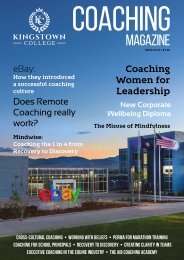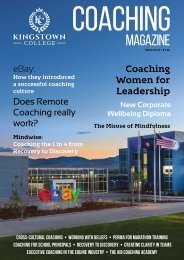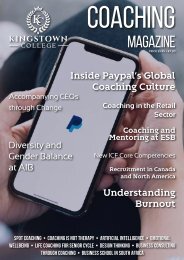Kingstown College Coaching Magazine vol.5 2019/2020
Welcome to another information filled publication of our Coaching Magazine!
Welcome to another information filled publication of our Coaching Magazine!
- No tags were found...
Create successful ePaper yourself
Turn your PDF publications into a flip-book with our unique Google optimized e-Paper software.
38 Coaching Magazine Vol.5
A knee-jerk response is to make
everyone aware of everything,
which is likely to result in vital data
being buried in an overwhelming
mass of trivia and irrelevant data
from every other TOT. McCrystal
recommends pushing decisionmaking
to the lowest practical level.
For this to be effective, however,
teams need shared communication
and decision-making protocols and
– over and above this – an instinctive
understanding of what other teams
need to know.
Artificial intelligence has much
to offer in terms of learning when
and where to route information
of this kind, but a great deal can
be achieved by old-fashioned
conversation. Regular and ad hoc
inter-team reviews of cases – both
ones that went well and one’s
that didn’t – can build collective
instinctive understanding of what
needs to be transmitted along with
the level of urgency. They also
reinforce shared accountability. The
systems that genuinely enhance
collaboration between TOTs are
rarely imposed top-down – they are
a continuous, emergent learning
process that constitutes collective,
adaptive intelligence.
A pragmatic set of coaching
questions to explore communication
between teams is:
• What information that we
could provide would be most
helpful to you in making good
decisions?
• When will it be most helpful?
• How can we provide it in the
most helpful way?
To facilitate these conversations,
team coaches can work at the
interface between teams, supporting
them when they come together to
determine what decisions require
or will benefit from input from more
than one team. Among questions
that are helpful here are:
• Who is best positioned to
make this decision (e.g. from
a position of timeliness, and
having sufficient information to
assess the situation)?
• Who should input into the
decision, how and when?
Although there may be some
argument and give and take,
recasting decision-making as a
collaborative activity between
teams helps to break down the
“them and us” boundaries even
further.
How can teams of teams better
learn together?
Much of what has been described
above is in essence about colearning
across team boundaries.
When coaching individual teams,
a team development plan, which
links personal development with
team development and the business
plan is an increasingly common and
practical approach, now standard
for all coaches, who have trained
through Coaching and Mentoring
International.
It is much more difficult to
identify and manage learning
that is needed across and by the
system, but the same principles
apply. Team development plans
can be amalgamated into TOT
development plans that link directly
to the organizational purpose. An
outcome of doing so may be the
identification of hidden centres
of excellence – small but valuable
caches of experience and skill that
can be enhanced and made more
widely accessible, if other teams
know about and value them.
The TOT development plan plays a
vital role in regular (at least annual)
reviews of learning by the system.
Team coaching focuses on helping
teams improve performance (what
they do), capability (what it will be
able to do in the future, if it acquires
the knowledge, processes and
resources) and capacity (how it will
do more with less, as Peter Hawkins
expresses it). TOT development
plans address the same issues and
help teams think beyond their own
horizons, expanding the collective
consciousness and reinforcing
responsibilities to the system rather
than just to a team or an individual
job description.
How can teams of teams use
leadership to greatest effect?
Leadership is not the same
as being a leader. Traditional
hierarchies focus on the role of
the leader, who is expected to
be in control of everything, but
increasingly can’t. The linking pin
model of organizations assumes
that leaders at one level will
become a team under a leader at
the next higher level. It breaks
down, of course, because it
requires only one weak link for
the chain to break. Effective team
coaching clarifies the functions
of leadership and enables the
team to explore together how
these might best be delivered.
A typical outcome is that the
appointed leader knows how best
to add value and that they are
valued by the team. It also frees
them up to focus on tasks that are
more important to building future
capability and capacity.






